Carthaginian Army › Ancient Egyptian Writing » Ancient origins
Articles and Definitions › Contents
- Carthaginian Army › Antique Origins
- Ancient Egyptian Writing › Ancient History
Ancient civilizations › Historical and archaeological sites
Carthaginian Army › Antique Origins
Definition and Origins
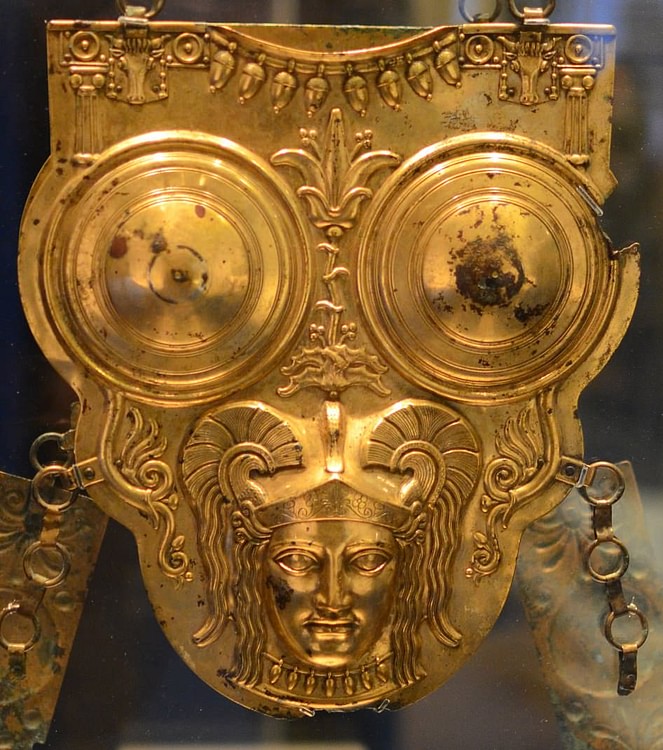
The armies of Carthage permitted the city to forge the most powerful empire in the western Mediterranean from the 6th to 3rd centuries BCE. Although by tradition a seafaring nation with a powerful navy, Carthage, by necessity, had to employ a land army to further their territorial claims and match their enemies. Adopting the weapons and tactics of the Hellenistic kingdoms, Carthage similarly employed mercenary armies from their allies and subject city-states. Military successes came in Africa, Sicily, Spain, and Italy, where armies were led by such celebrated commanders as Hamilcar Barca and Hannibal.Carthage's military dominance was, though, eventually challenged and bested by the rise of Rome and, following defeat in the Second Punic War (218-201 BCE), Carthage's days as a regional powerhouse were over.
THE CARTHAGINIAN EMPIRE
Carthage was founded in the 9th century BCE by settlers from the Phoenician city of Tyre, but within a century the city would go on to found colonies of its own. An empire was created which covered North Africa, the Iberian Peninsula, Sicily, and other islands of the Mediterranean. The new territory would be a source of vast wealth and manpower. Conversely, this would also bring Carthage into direct competition not only with local tribes but also contemporary powers, notably the Greek potentates and later Rome. In turn, this created a necessity for large military forces, especially land armies.
COMMANDERS
The commander of a Carthaginian army in the field ( rab mahanet ) was selected for the duration of a specific war, usually from the ruling family. The general may often have had complete autonomy of action or, on other occasions, had to rely on the council of 104 and the two most important political persons at Carthage, the two suffetes (magistrates), for such important decisions as when to hold a truce, sue for peace, or withdraw. In addition, after a battle or war, the commanders would be subject to a tribunal which investigated their competence or otherwise. Different family groups within Carthage had their own private armies, which could then be employed for the state; a situation which caused intense rivalry between commanders. In addition, command was sometimes shared between two, or even three, generals, creating more opportunities for fierce competition.
THE CARTHAGINIAN ARMY WAS COMPOSED OF CITIZEN HOPLITES, AFRICAN CAVALRY, & MERCENARIES FROM ACROSS THE EMPIRE.
Motivation must have been high as those generals who failed in wartime were treated harshly. One of the lesser punishments was a large fine whilst the worst case scenario was crucifixion. Several commanders, following defeat, committed suicide to avoid the latter penalty, although, this did not stop the council of 104 crucifying the corpse of one Mago c. 344 BCE. A serious consequence to the fear of failure inherent in the army command structure may have been that generals tended to be over-cautious and conservative in battle.
ORGANISATION
The army of Carthage itself was composed of heavily armoured infantry drawn from the citizenry. This was an elite group of 2,500-3,000 infantry soldiers identified by their white shields and known as the Sacred Band. The name is copied from the elite army of Greek Thebes and indicates a general move away from Near Eastern practices to a Hellenization of the Carthaginian military from the 4th century BCE. The Sacred Band was barracked within the massive fortification walls of Carthage. A second source of troops was the allied cities and the conquered territory of North Africa, especially ancient Libya and Tunisia.These would have been led by Carthaginian officers and were paid for their service.

Carthaginian Sacred Band Hoplite
As neither of the previous two groups were very numerous or enjoyed a particularly glorious reputation in battle – after all, the Carthaginians were noted for their navy – a third group of professional mercenaries was relied upon to create an army which could match the enemies of Carthage. These came from all Carthage's allied and conquered states around the Mediterranean, especially Greece, Iberia, Gaul, and southern Italy. Another notable component of a Carthaginian army in the field was the highly skilled Numidian cavalry whose riders armed themselves with a javelin and rode without a bridle, such was their skill in controlling their mount. They carried a small shield for protection and also threw long poisoned darts at the enemy. An unusual contingent of mercenaries came from Libyan-Egyptian lands which fielded women in battle, usually riding chariots or horses.They carried crescent-shaped pelta shields and wielded double axes.
All of these groups of mercenaries remained a permanent fixture of the Carthaginian standing army from the end of the 3rd century BCE. To avoid the threat that successful mercenary armies took it into their heads to depose the ruling elite of Carthage and take the city's wealth for themselves the Carthaginians made sure that all senior and middle command positions were held by citizens of Carthage. Nevertheless, despite this precaution, in several instances mercenary armies would prove to be disloyal and even cause in-fighting between the rival clans of Carthage's aristocracy, most famously during the Truceless War (aka Mercenary War, 241-237 BCE).
WEAPONS & ARMOUR
As the armies of Carthage were usually composite groups of Punic, African, and foreign mercenary forces their weapons and armour differed depending on the unit's origin or preferences. In addition, the Carthaginians were not averse to equipping themselves with the arms and armour of their fallen enemies. Contact with Greek forces in Magna Graecia and Sicily resulted in the Carthaginians themselves adopting such quintessentially Greek paraphernalia as the crested bronze Corinthian and Thracian helmets and heavy hoplite armour (a metal or leather tunic and greaves to protect the lower legs). Older style conical helmets were worn, as were helmets with face masks and metal breastplates covered in leather copied from Cypriot armour. The strengthened linen cuirass ( linothorax ) studded with bronze bosses and with hanging strips ( pteryges ) to protect the groin were also copied from Greek warriors.
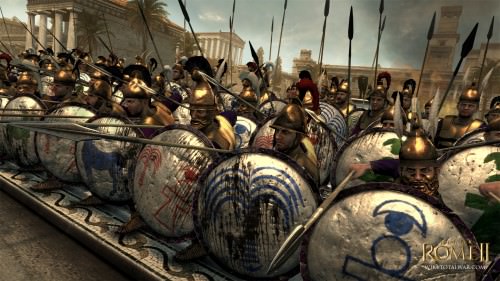
Carthaginian Mercenaries
Shields were circular (around 90 cm in diameter) or oval with a central vertical rib (the thyreos-type), although Celtic troops, for example, had a narrow rectangular shield of oak. Shields were decorated with motifs related to Punic religion, classic motifs such as Medusa, the Evil eye, or even personalised – Hasdrubal Barca had his own portrait on his silver shield. The Carthaginians seemed to have dressed up for battle with plenty of gold jewellery and animal skins being worn, especially by officers. Carthaginian officers would have further stood out in the heat of battle due to their impressive helmet plumes and glinting precious-metal armour. Generals often had expensive scale armour, such as that worn by Hannibal made from gilded bronze scales and inherited from his father.
The typical weapon was the sword, either with a straight blade or a curved single-edged one, the kopis of the Near East, with a dagger as a backup. Celts famously used long slashing swords while Iberian infantry had distinctive curved swords. Spanish tribes also used a short sword with great effect; something which did not go unnoticed by the Romans who would later adopt a similar type themselves, the gladius hispaniensis.
Archers were used, especially the skilled Moors and Cretans, but much less than in other armies. Bowmen were chiefly employed in chariots or on elephants to fire down on opposing infantry. Other weapons used were spears (3-6 m in length), short javelins (the principal cavalry weapon) and double-headed axes ( bipennis ). Slings were used to fire lead or stone bullets which were almond-shaped for maximum penetration into armour. They were especially used by the deadly mercenary slingers from the Balearic Islands.
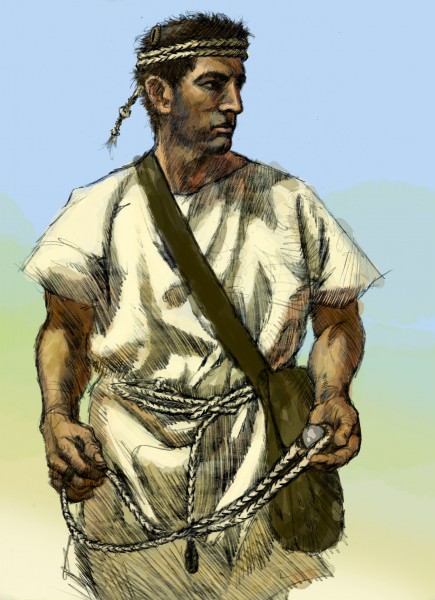
Balearic Slinger
Artillery was a component of Carthaginian armies in Sicily where the cities were well-fortified. The Carthaginians were quick to copy the Hellenistic inventions of catapult (for stones and incendiaries) and crossbows. During a siege, they also employed battering rams, mobile siege towers, mounds, and mining to overcome enemy fortifications. We know that Carthage itself was equipped with artillery machines for defence.
CHARIOTS
The Carthaginians employed war chariots up to the 3rd century BCE. These were constructed from wooden frames covered with panels of woven willow branches. They were single-axle chariots and could carry two men: a driver and an archer.Sometimes a third man, a hoplite, would join them. The wheels could be fitted with blades, and the team of two or four horses was protected with metal breastplates and ox-hide side covers. Like cavalry, they were used to break up the enemy infantry lines. Needing flat terrain to operate effectively they were largely restricted to use in North Africa and southern Spain and went completely out of use from the 3rd century BCE.
WAR ELEPHANTS
The Carthaginians used in warfare a now extinct variety of elephant once native to North Africa. Although, Hannibal may have had some larger Indian elephants via his ally Ptolemy II of Egypt. Tusked and reaching a height of 2.5 metres, the elephants were made even more fearsome by adding armour to the head, trunk, and sides and blades or spears to the tusks. Controlled by their driver ( mahout ) they were used to disrupt enemy formations. Not large enough to carry a superstructure ( howdah ), this variety of elephant may have permitted a second rider armed with a bow or javelins. Before battles, elephants would be given fermented wine to make them behave more erratically and increase their trumpeting and stamping. No doubt the appearance and noise of elephants caused panic amongst the enemy's men and horses, but they were wildly unpredictable in battle and could cause as much damage to their own side as the opposition. When enemy forces became used to them and trained their horses not to panic, or if the terrain was unsuitable, then their effectiveness was greatly reduced.
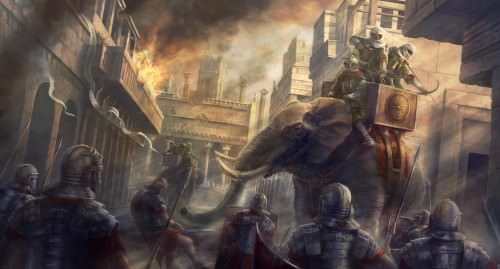
Carthaginian War Elephant
STRATEGIES & TACTICS
After an initial round of skirmishes involving light cavalry, the Carthaginian army attacked the enemy head-on with heavy infantry, much like the Greeks had been doing for centuries with the phalanx (a line of tightly grouped hoplites protecting each other with their shields). Following the successful Macedonian model of a speared phalanx, the Carthaginian army was similarly organised into companies of around 250 men organised into 16 lines of 16 troops, which then collectively formed battalions of around 4,000 men. Light infantry was stationed on the wings and protected the flanks of the phalanx which might draw in the enemy lines. Troops were coordinated during battle using standards which, for Carthaginian units, were staffs with ribbons topped by the familiar Punic crescent moon and sun disc symbol. Each ethnic group would have had their own standards such as the Celtic wild boar image and shield blazons were also used to identify who was who.
The elephant corps was used in front of the infantry to disrupt the opposition ranks and light cavalry units to harass the enemy from the wings or rear. There was also a small unit of heavy cavalry, composed of Carthaginian citizens only, which could break up the enemy's infantry lines mid-battle. Cavalry was also used to harass the enemy when in retreat. When not involved in head-to-head battles, the cavalry, especially the mobile and highly manoeuvrable Numidian corps, were used to ambush enemy troops or lead them into ambush by infantry troops.
In some battles, the Carthaginian army numbered up to 70,000 men (but more often less than half that figure) and its success was very much down to the commander's ability to galvanise all of the disparate groups into a cohesive fighting force. Hannibal was particularly renowned for his ability in this area and in his willingness to adapt superior enemy tactics and formations such as after the Battle of Lake Trasimene (217 BCE) when he likely adapted the more flexible Roman maniple troop deployment as opposed to the more static phalanx.
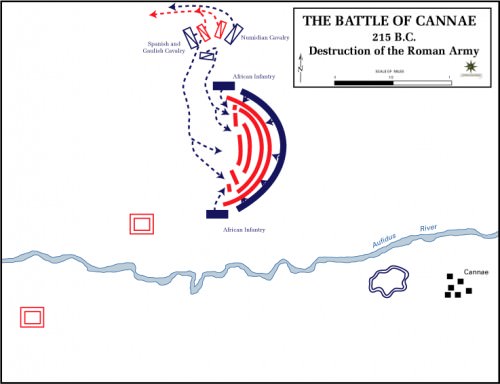
Battle of Cannae - Destruction of the Roman Army
CONCLUSION
In some theatres the Carthaginian army enjoyed great successes, notably in North Africa, Sicily, Spain, and Italy where Hannibal famously won four great battles against Rome. However, the Second Punic War was perhaps a turning point. The Roman general Scipio Africanus managed to persuade the Numidian cavalry to join his cause and defeated Hannibal and his elephants at the Battle of Zama (202 BCE). Rome, with its standardised, well-equipped and well-drilled armies, which could be replaced from a seemingly never-ending supply of manpower and wealth, had taken ancient warfare to a new level of professionalism. The inherent weaknesses in the Carthaginian army - disparate groups of sometimes disloyal mercenaries, confused command structures, and an over-reliance on heavy infantry and war elephants - meant that Carthage was, ultimately, unable to maintain its position as a Mediterranean superpower and keep pace with mighty Rome.
Ancient Egyptian Writing › Ancient History
Definition and Origins
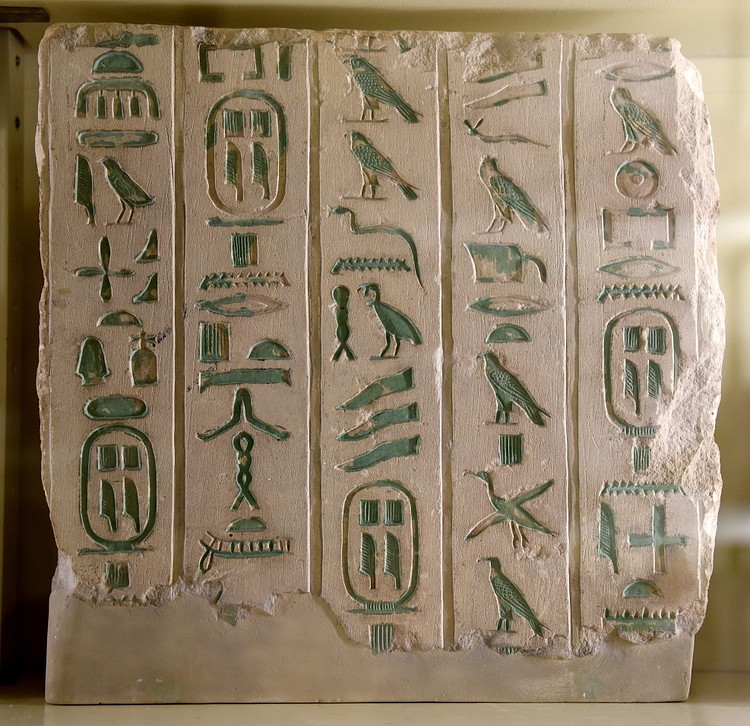
Ancient Egyptian writing is known as hieroglyphics ('sacred carvings') and developed at some point prior to the Early Dynastic Period (c. 3150 -2613 BCE). According to some scholars, the concept of the written word was first developed in Mesopotamia and came to Egypt through trade. While there certainly was cross-cultural exchange between the two regions, Egyptian hieroglyphics are completely Egyptian in origin; there is no evidence of early writings which describe non-Egyptian concepts, places, or objects, and early Egyptian pictographs have no correlation to early Mesopotamian signs. The designation 'hieroglyphics' is a Greek word; the Egyptians referred to their writing as medu-netjer, 'the god's words,' as they believed writing had been given to them by the great god Thoth.
According to one ancient Egyptian tale, in the beginning of time Thoth created himself and, in the form of an ibis, lay the cosmic egg which held all of creation. In another story, Thoth emerged from the lips of the sun god Ra at the dawn of time, and in another, he was born of the contendings of the gods Horus and Set, representing the forces of order and chaos. In all of these, however, the constant is that Thoth was born with an immense breadth of knowledge and, among the most important, the knowledge of the power of words.
Thoth gave human beings this knowledge freely, but it was a responsibility he expected them to take seriously. Words could hurt, heal, elevate, destroy, condemn, and even raise someone from death to life. Egyptologist Rosalie David comments on this:
The main purpose of writing was not decorative, and it was not originally intended for literary or commercial use.Its most important function was to provide a means by which certain concepts or events could be brought into existence. The Egyptians believed that if something were comitted to writing it could be repeatedly "made to happen" by means of magic. (199)

Thoth
This concept is not as strange as it might first appear. Any writer knows that one often has no idea what one wants to say until the end of the first draft, and every avid reader understands the "magic" of discovering unknown worlds between the covers of a book and making that magic happen again each time the book is opened. David's reference to "concepts or events" coming into existence through writing is a common understanding among writers. American author William Faulkner stated in his Nobel Prize address that he wrote "to create out of the materials of the human spirit something which did not exist before" (1).This same motivation has been expressed in different words by many writers over the centuries, but before any of them even existed the ancient Egyptians understood this concept well. The great gift of Thoth was the ability not only to express one's self but to literally be able to change the world through the power of words. Before that could happen, however, before the gift could be put to its full use, it had to be understood.
THE CREATION OF WRITING
However much Thoth had to do with giving humans their system of writing (and, to the Egyptians, 'humanity' equaled 'Egyptian'), the ancient Egyptians had to work out for themselves what this gift was and how to use it. Sometime in the latter part of the Predynastic Period in Egypt (c. 6000 - c. 3150 BCE), they began to use symbols to represent simple concepts.Egyptologist Miriam Lichtheim writes how this early script "was limited to the briefest notations designed to identify a person or a place, an event or a possession" (3). Most likely the earliest purpose writing served was in trade, to convey information about goods, prices, purchases, between one point and another. The first actual extant evidence of Egyptian writing, however, comes from tombs in the form of Offering Lists in the Early Dynastic Period.

Egyptian Hieroglyphics
Death was not the end of life for the ancient Egyptians; it was only a transition from one state to another. The dead lived on in the afterlife and relied upon the living to remember them and present them with offerings of food and drink. An Offering List was an inventory of the gifts due to a particular person and inscribed on the wall of their tomb. Someone who had performed great deeds, held a high position of authority, or led troops to victory in battle were due greater offerings than another who had done relatively little with their lives. Along with the list was a brief epitaph stating who the person was, what they had done, and why they were due such offerings. These lists and epitaphs might sometimes be quite brief but most of the time were not and became longer as this practice continued. Lichtheim explains:
The Offering List grew to enormous length till the day on which an inventive mind realized that a short Prayer for Offerings would be an effective substitute for the unwieldy list. Once the prayer, which may already have existed in spoken form, was put into writing, it became the basic element around which tomb-texts and representations were organized. Similarly, the ever lengthening lists of an official's ranks and titles were infused with life when the imagination began to flesh them out with narration, and the Autobiography was born. (3)
The autobiography and the prayer became the first forms of literature in Egypt and were created using the hieroglyphic script.
DEVELOPMENT & USE OF HIEROGLYPHIC SCRIPT
Hieroglyphics developed out of the early pictographs. People used symbols, pictures to represent concepts such as a person or event. The problem with a pictogram, however, is that the information it contains is quite limited. One may draw a picture of a woman and a temple and a sheep but has no way of relaying their connection. Is the woman coming from or going to the temple? Is the sheep an offering she is leading to the priests or a gift to her from them? Is the woman even going to the temple at all or is she merely walking a sheep in the vicinity? Are the woman and sheep even related at all? The early pictographic writing lacked any ability to answer these questions.
THE EGYPTIANS DEVELOPED THE SAME SYSTEM AS THE SUMERIANS BUT ADDED LOGOGRAMS (SYMBOLS REPRESENTING WORDS) AND IDEOGRAMS TO THEIR SCRIPT.
The Sumerians of ancient Mesopotamia had already come upon this problem in writing and created an advanced script c.3200 BCE in the city of Uruk. The theory that Egyptian script developed from Mesopotamian writing is most sharply challenged by this development, in fact, because if the Egyptians had learned the art of writing from the Sumerians, they would have bypassed the stage of pictograms and begun with the Sumerian creation of phonograms - symbols which represent sound. The Sumerians learned to expand their written language through symbols directly representing that language so that if they wished to relay some specific information regarding a woman, a temple, and a sheep, they could write, "The woman took the sheep as an offering to the temple," and the message was clear.
The Egyptians developed this same system but added logograms (symbols representing words) and ideograms to their script.An ideogram is a 'sense sign' that conveys a certain message clearly through a recognizable symbol. The best example of an ideogram is probably a minus sign: one recognizes that it means subtraction. The emoji is a modern example familiar to anyone acquainted with texting; placing the image of a laughing face at the end of one's sentence lets a reader know that one is joking or finds the subject funny. The phonogram, logogram, and ideogram made up the basis for hieroglyphic script. Rosalie David explains:
There are three types of phonograms in hieroglypics: uniliteral or alphabetic signs, where one hieroglyph(picture) represents a single consonant or sound value; biliteral signs, where one heiroglyph represents two consonants; and triliteral signs where one hieroglyph represents three consonants. There are twenty-four herioglyphic signs in the Egyptian alphabet and these are the phonograms most commonly used. But since there was never a purely alphabetic system, these signs were placed alongside other phonograms (biliterals and triliterals) and ideograms. Ideograms were often placed at the end of a word (spelled out in phonograms) to clarify the meaning of that word and, when used in this way, we refer to them as "determinatives." This assists in two ways: the addition of a determinative helps to clarify the meaning of a particular word, since some words look similar or identical to each other when spelled out and written down only in the phonograms; and beacuse determinatives stand at the end of the word they can indicate where one word ends and another begins. (193)

Egyptian Stela of Horemheb
A modern-day example of how hieroglyphics were written would be a text message in which an emoji of an angry face is placed after an image of a school. Without having to use any words one could convey the concept of "I hate school" or "I am angry about school." If one wanted to make one's problem clearer, one could place an image of a teacher or fellow student before the angry-face-ideogram or a series of pictures telling a story of a problem one had with a teacher. Determinatives were important in the script, especially because hieroglyphics could be written left-to-right or right-to-left or down-to-up or up-to-down. Inscriptions over temple doors, palace gates, and tombs go in whatever direction was best served for that message.The beauty of the final work was the only consideration in which direction the script was to be read. Egyptologist Karl-Theodor Zauzich notes:
The placement of hieroglyphs in relation to one another was governed by aesthetic rules. The Egyptians always tried to group signs in balanced rectangles. For example, the word for "health" was written with the three consonants snb. These would not be written [in a linear fashion] by an Egyptian because the group would look ugly, it would be considered "incorrect". The "correct" writing would be the grouping of the signs into a rectangle...The labor of construction was lightened somewhat by the fact that individual hieroglyphs could be enlarged or shrunk as the grouping required and that some signs could be placed either horizontally or vertically.Scribes would even reverse the order of signs if it seemed that a more balanced rectangle could be obtained by writing them in the wrong order. (4)
The script could easily be read by recognizing the direction the phonograms were facing. Images in any inscription always face the beginning of the line of text; if the text is to be read left-to-right then the faces of the people, birds, and animals will be looking to the left. These sentences were easy enough to read for those who knew the Egyptian language but not for others.Zauzich notes how "nowhere among all the hieroglyphs is there a single sign that represents the sound of a vowel" (6). Vowels were placed in a sentence by the reader who understood the spoken language. Zauzich writes:
This is less complicated than it sounds. For example, any of us can read an advertisement that consists almost entirely of consonants:3rd flr apt in hse, 4 lg rms, exclnt loc nr cntr, prkg, wb-frpl, hdwd flrs, skylts, ldry, $600 incl ht (6).
In this same way, the ancient Egyptians would be able to read hieroglyphic script by recognizing what 'letters' were missing in a sentence and applying them.
OTHER SCRIPTS
Hieroglyphics were comprised of an 'alphabet' of 24 basic consonants which would convey meaning but over 800 different symbols to express that meaning precisely which all had to be memorized and used correctly. Zauzich answers the question which may immediately come to mind:
It may well be asked why the Egyptians developed a complicated writing system that used several hundred signs when they could have used their alphabet of some thirty signs and made their language much easier to read and write. This puzzling fact probably has a historical explanation: the one-consonant signs were not "discovered" until after the other signs were in use. Since by that time the entire writing system was established, it could not be discarded, for specific religious reasons. Hieroglyphics were regarded as a precious gift of Thoth, the god of wisdom. To stop using many of these signs and to change the entire system of writing would have been considered both a sacrilege and an immense loss, not to mention the fact that such a change would make all the older texts meaningless at a single blow. (11)
Even so, hieroglyphics were obviously quite labor-intensive for a scribe and so another faster script was developed shortly after known as hieratic ('sacred writing'). Hieratic script used characters which were simplified versions of hieroglyphic symbols. Hieratic appeared in the Early Dynastic Period in Egypt after hieroglyphic writing was already firmly developed.

Hieratic Book of the Dead of Padimin
Hieroglyphics continued to be used throughout Egypt's history in all forms of writing but came primarily to be the script of monuments and temples. Hieroglyphics, grouped in their beautifully formed rectangles, leant themselves to the grandeur of monumental inscriptions. Hieratic came to be used first in religious texts but then in other areas such as business administration, magical texts, personal and business letters, and legal documents such as wills and court records. Hieratic was written on papyrus or ostraca and practiced on stone and wood. It developed into a cursive script around 800 BCE (known as 'abnormal hieratic') and then was replaced c. 700 BCE by demotic script.

Rosetta Stone Detail, Demotic Text
LOSS & DISCOVERY
It has been argued that the meaning of hieroglyphics was lost throughout the later periods of Egyptian history as people forgot how to read and write the symbols. Actually, hieroglyphics were still in use as late as the Ptolemaic Dynasty and only fell out of favor with the rise of the new religion of Christianity during the early Roman Period. There were lapses throughout the country's history in the use of hieroglyphics, but the art was not lost until the world the script represented changed. As Coptic script continued to be used in the new paradigm of Egyptian culture ; hieroglyphic writing faded into memory. By the time of the Arab Invasion of the 7th century CE, no one living in Egypt knew what the hieroglyphic inscriptions meant.
When the European nations began exploring the country in the 17th century CE, they had no more of an idea that the hieroglyphics were a written language than the Muslims had. In the 17th century CE, hieroglyphics were firmly claimed to be magical symbols and this understanding was primarily encouraged through the work of the German scholar and polymath Athanasius Kircher (1620-1680 CE). Kircher followed the lead of ancient Greek writers who had also failed to understand the meaning of hieroglyphics and believed they were symbols. Taking their interpretation as fact instead of conjecture, Kircher insisted on an interpretation where each symbol represented a concept, much in the way the modern peace sign would be understood. His attempts to decipher Egyptian writing failed, therefore, because he was operating from a wrong model.
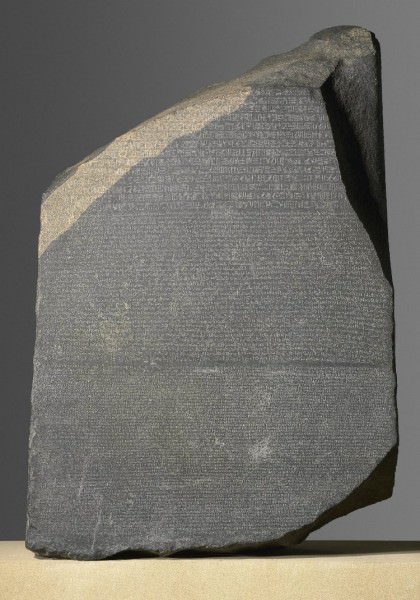
Rosetta Stone
Many other scholars would attempt to decipher the meaning of the ancient Egyptian symbols without success between Kircher's work and the 19th century CE but had no basis for understanding what they were working with. Even when it seemed as though the symbols suggested a certain pattern such as one would find in a writing system, there was no way to recognize what those patterns translated to. In 1798 CE, however, when Napoleon's army invaded Egypt, the Rosetta Stone was discovered by one of his lieutenants, who recognized its potential importance and had it sent to Napoleon's institute for study in Cairo. The Rosetta Stone is a proclamation in Greek, hieroglyphics, and demotic from the reign of Ptolemy V (204-181 BCE). All three texts relay the same information in keeping with the Ptolemaic ideal of a multi-cultural society; whether one read Greek, hieroglyphic, or demotic, one would be able to understand the message on the stone.
Work on deciphering hieroglyphics with the help of the stone was delayed until the English defeated the French in the Napoleonic Wars and the stone was brought from Cairo to England. Once there, scholars set about trying to understand the ancient writing system but were still working from the earlier understanding Kircher had so convincingly advanced. The English polymath and scholar Thomas Young (1773-1829 CE) came to believe that the symbols represented words and that hieroglyphics were closely related to demotic and later Coptic scripts. His work was built upon by his sometimes-colleague-sometimes-rival, the philologist and scholar Jean-Francois Champollion (1790-1832 CE).

Champollion's notes from the Rosetta Stone
Champollion's name is forever linked with the Rosetta Stone and the decipherment of hieroglyphics because of the famous publication of his work in 1824 CE which conclusively showed that Egyptian hieroglyphics were a writing system composed of phonograms, logograms, and ideograms. Contention between Young and Champollion over who made the more significant discoveries and who deserves the greater credit is reflected in the same ongoing debate in the present day by scholars. It seems quite clear, however, that Young's work lay the foundation on which Champollion was able to build but it was Champollion's breakthrough which finally deciphered the ancient writing system and opened up Egyptian culture and history for the world.
LICENSE:
Article based on information obtained from these sources:with permission from the Website Ancient History Encyclopedia
Content is available under License Creative Commons: Attribution-NonCommercial-ShareAlike 3.0 Unported. CC-BY-NC-SA License